Railay Beach, Thailand (Brief nudity)
22 March 2006 (Looking back to late January)
When the tsunami of December 2004 swept into the Railay Beach area, climbers scrambled up cliffs and sunbathers ran for the jungle to escape the surge. Unlike many areas, Railay was partly protected from the worst of the waves by islands and reefs, so there was less damage and death there than elsewhere. Nevertheless, the official Thai tsunami website reports 721 dead in the Krabi area and includes an eerie list of unidentified victims (with descriptions) as of a year ago when the site was last updated. Sam Lightner, a Jackson (Wyoming) friend who authored a climbing guide to the area and lives there part of the year, wrote that although few climbers were apparently killed at Railay, many may have perished snorkeling or visiting nearby areas like Koh Pi Pi, which was devastated. Sam tells (in his guidebook) of finding a climber’s t-shirt at the base of an island cliff that received a direct hit from the wave. Another climber (in Boulder) told me of barely escaping the wave while on a snorkeling trip, thanks to his alert boatman who managed to push his longtail boat at full throttle, just ahead of the wave, to the shelter of an intervening peninsula.
We arrived at Railay just slightly more than one year after the tsunami and for us it was difficult to see any residual damage. In fact, there is so much new building in the area to accommodate the returning hordes of tourists that the construction has overwhelmed any obvious tsunami debris. A few damaged longtail boats abandoned on the fringes of some of the beaches and a broken sailboat keel in the shallows between Railay and Tonsai were the only signs I saw of the chaos of a year earlier. It feels a little odd to be a hedonistic tourist in an area that so recently suffered natural disaster and loss of life, but the economy of the area depends on people visiting and so perhaps our tourist dollars contributed. Sam Lightner reported that, to their credit, climbers were a strong part of the small subset of tourists that stayed in Thailand after the wave to help with the recovery.
We spent two weeks at the Railay/Tonsai/Phra Nang Beach area climbing, swimming, eating, lounging and socializing. Despite our shockingly poor climbing fitness after a workout-less semester in Lijiang, we had a great time groveling up easy climbing routes on the stunning limestone cliffs that rise directly out of white sand beaches. And Bei had a great time reacquainting herself with water, which she loves. It was all we could do to pull her from the ocean or the pool, where she quickly regained and then surpassed her previous swimming skills. By the end of the two weeks she was happily paddling all over the pool by herself without the need for parental support.
On the hedonistic side, we found that we could still excel at luxury eating after a half year of Chinese rice and stir-fry. I’m certain that we gained weight at Railay despite constant sweating in the relentless tropical heat. For me, Thai cuisine is as big an attraction as any other aspect of the country, and I stuffed myself daily with fresh fish (red snapper, marlin, king), curries (coconut, green and red) and milkshakes (coconut, chocolate, vanilla). We spent what little time remained after meals and pool sesssions with Bei wandering the area in search of obscure cliffs with easy climbs so that we could feebly ascend in quiet anonymity, far from the judging eyes of younger, fitter climbers.
Here are some photos:
Bei reveled in water. After months in Lijiang, where swimming is limited to ineffective splashing in the bathtub, she attempted to stay wet for the entire 2 weeks that we were at Railay. We forced her out for meals, sleep and our occasional attempts at climbing.
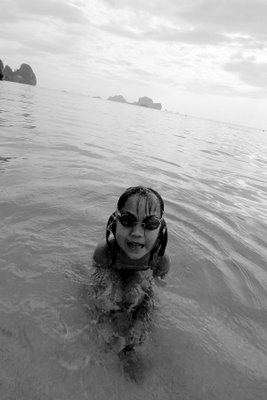
Ellen and Bei on Tonsai Beach, just around a point from the main Railay beach area. Tonsai has become a climbers village (ghetto?) due to the high concentration of great cliffs there, but the beach is not bad either.
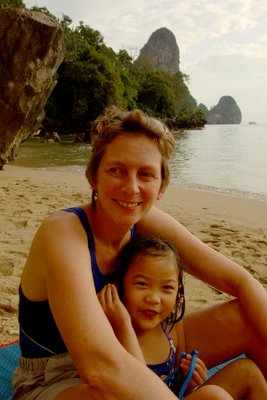
Railay is accesible only by water. The local "longtail boats" are the primary mode of transportation to the area from the nearby towns of Krabi and Ao Nang. They are as much a part of the scenery at Railay as the beaches themselves.

And the beaches. Though longtail boats are attractive, they aren't always the most distracting visual. Europeans come to Railay to tan all parts of their bodies despite the Thai distaste for public nudity. Bei uses a prop to illustrate, though Barbie's famous proportions do not tell the whole story. Portly German men in thongs also explosed themselves the sun and our heads snapped quickly back to the longtails, which had more pleasing craftsmanship.
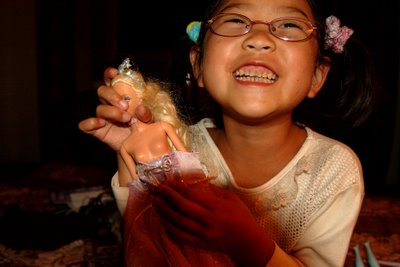
When I lived at Railay for 2 months in 1996, Tonsai supported one small set of bungalows--primitive bamboo affairs hugging the boundary between beach and jungle. In the intervening 10 years, it has become a climber's mecca, and roads hacked deep into the once pristine jungle now lead to more bungalow complexes than I could count, along with restaurants, climbing schools and convenience stores. Although we are all part of the pressure that leads to this kind of development, most of the climbers I talked to who had visited Railay in the past lamented the changes. Here, climbers mill about beneath the main Tonsai cliff where perfect steep routes emerge from the sandy beach.
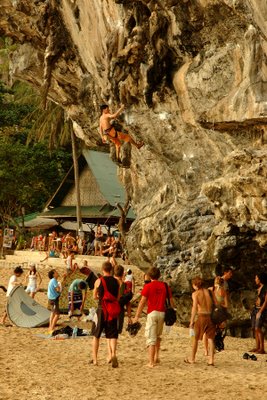
Bei enjoying one the beaches at Railay West.

Vendors rest in the shade at the entrance to Phra Nang Beach at the end of the Railay Peninsula.

Boatmen unload bundles of Bird-of-Paradise flowers to be used for decoration in one of the expensive Railay resort hotels. Each morning Thai workers ride the boats from Krabi and Ao Nang--the two closest towns--to Railay and march across the muddy tidal flats to their jobs in these hotels. Many work hard unloading boats in the hot sun while others cook or clean or greet guests. Amazingly hospitable, the workers seemed to have an almost inhuman ability to smile in the face of sometimes classically rude foreign tourists. In the evening they load back into the boats for the trip home.

The rock at Railay is nothing if not striking. Limestone cliffs dripping with huge stalagtites hang over green jungle, white beaches and turquoise water. It's no wonder that climbers are drawn to this area, where the climbing routes can be as incredible as they are beautiful. This cliff looms above the jungle behind Tonsai Beach.

Luckily for us, not all of the climbing was this steep, though it was fun to watch locals scamper up brutally difficult routes. Diminished by age and by months in China with no climbing, we could only watch and wish that we were strong enough to pull up onto these overhung routes. Instead we puffed and sweated our way up easier climbs on less public cliffs where we were less likely to be laughed at. The tsunami would have submerged this climber, about 20 feet above the beach, when it hit a year ago.

The upper portion of the climb shown in the previous photos. Difficulty and unrelenting steepness are only part of the story here. Remember that all activity takes place in 90+ degree temperatures and high humidity. Just sitting by the pool at the bungalow can sap your will to slog to the store for a soda.

A climber rests on the rope while looking for holds on the rock above. We struck similar poses on rock that was vertical or less.

Monkeys are a big part of life in southern Thailand. At a Buddhist temple complex called Tiger Cave about 10 km from Railay this monkey and others like it brazenly swoop out of the forest to steal ice cream from startled visitors. Bei cried for 15 minutes after a monkey that we had naively watched in delight as it watched back from a nearby perch suddenly dove headlong onto our table, spilled a bottle of gatorade onto her lap and snatched her ice cream before dashing back into its tree. Later we saw an entire family of monkeys contentedly licking ice cream bars.

I'd feel this way too if I ate 10 ice creams a day.

Even after ice cream these little monkeys can outclimb even the fittest young human.

The monk and the monkey. This old monkey had long ago given up the bad karma of its ice cream stealing ways and befriended the monks at Tiger Cave. From what we could tell, his biggest joy in life was having his furry belly scratched by whomever would succumb to big, pleading monkey eyes.

We were among the succumbers. After I scratched and rubbed the old man's belly for 10 minuted it reciprocated by picking through the hair on my legs in search of nits or whatever it is that monkeys search for on one another. Disturbingly, it seemed to find some, which it ate to Bei's delight.

Climbing was not Bei's favorite activity at Railay since it required her to be out of the water for several hours at a time. We tried our best to maintain peace by dragging Barbies and food to the cliffs. Bei usually managed to engage whoever she could in Barbie fantasy play--women climbers were the most common victims.

Longtail boats at Tonsai beach.

A lizard along a jungle path behind Tonsai beach. Lizards in southern Thailand range from little ones like this to huge water monitors that can be many feet long.

Yes, we did it again. We rented a scooter for a day trip to the Tiger Cave temple area. But to our credit, the traffic in this more rural area was not scary like in Chiang Mai and there were three of us on the bike, so Bei was safely pinned between two adult crash pads. And the helmets fit better than the Chiang Mai helmets we had used.

A scene from the Reclining Buddha cave near the town of Ao Nang. A large Buddah statue rests comfortably in a shallow limestone cave looking out onto the nearby highway. We stopped to have a look around on our way to Tiger Cave.

Small stuppas in front of a plantation of rubber trees. Rubber trees occupy much of the accessible land along the roads of southern Thailand.

A Buddha at the Tiger Cave temple complex. Monks live in shallow caves along a cliff in the jungle.
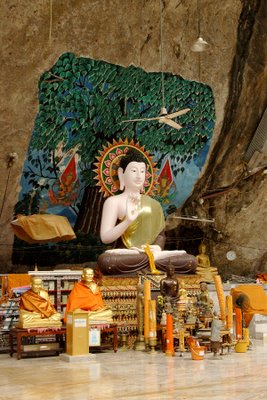
A painting on the limestone at Tiger Cave.
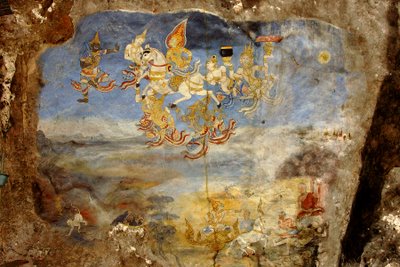
Even monks need to make phone calls. What! No cell phone?

Bei and Ellen exploring in one of the deeper caves at the Tiger Cave area.

Huge jungle trees have been spared from harvest by their location in this Buddhist sanctuary. Although logging is illegal in this part of Thailand now, it is uncommon to see such large trees, at least near roads. Perhaps there are many in the deeper jungles, but one would have to risk wrestling with cobras to find them.

Another big tree at Tiger Cave.

Roots adorned with silk sashes in the jungle.

And a final shot of the ubiquitous longtail. We trundled our considerable luggage back into one of these boats at the end of our stay to begin our journey back to China via Bangkok. A 15- minute ride across the placid Andaman Sea deposited us on a concrete pier that led to a waiting van which whisked us off to the airport.

When the tsunami of December 2004 swept into the Railay Beach area, climbers scrambled up cliffs and sunbathers ran for the jungle to escape the surge. Unlike many areas, Railay was partly protected from the worst of the waves by islands and reefs, so there was less damage and death there than elsewhere. Nevertheless, the official Thai tsunami website reports 721 dead in the Krabi area and includes an eerie list of unidentified victims (with descriptions) as of a year ago when the site was last updated. Sam Lightner, a Jackson (Wyoming) friend who authored a climbing guide to the area and lives there part of the year, wrote that although few climbers were apparently killed at Railay, many may have perished snorkeling or visiting nearby areas like Koh Pi Pi, which was devastated. Sam tells (in his guidebook) of finding a climber’s t-shirt at the base of an island cliff that received a direct hit from the wave. Another climber (in Boulder) told me of barely escaping the wave while on a snorkeling trip, thanks to his alert boatman who managed to push his longtail boat at full throttle, just ahead of the wave, to the shelter of an intervening peninsula.
We arrived at Railay just slightly more than one year after the tsunami and for us it was difficult to see any residual damage. In fact, there is so much new building in the area to accommodate the returning hordes of tourists that the construction has overwhelmed any obvious tsunami debris. A few damaged longtail boats abandoned on the fringes of some of the beaches and a broken sailboat keel in the shallows between Railay and Tonsai were the only signs I saw of the chaos of a year earlier. It feels a little odd to be a hedonistic tourist in an area that so recently suffered natural disaster and loss of life, but the economy of the area depends on people visiting and so perhaps our tourist dollars contributed. Sam Lightner reported that, to their credit, climbers were a strong part of the small subset of tourists that stayed in Thailand after the wave to help with the recovery.
We spent two weeks at the Railay/Tonsai/Phra Nang Beach area climbing, swimming, eating, lounging and socializing. Despite our shockingly poor climbing fitness after a workout-less semester in Lijiang, we had a great time groveling up easy climbing routes on the stunning limestone cliffs that rise directly out of white sand beaches. And Bei had a great time reacquainting herself with water, which she loves. It was all we could do to pull her from the ocean or the pool, where she quickly regained and then surpassed her previous swimming skills. By the end of the two weeks she was happily paddling all over the pool by herself without the need for parental support.
On the hedonistic side, we found that we could still excel at luxury eating after a half year of Chinese rice and stir-fry. I’m certain that we gained weight at Railay despite constant sweating in the relentless tropical heat. For me, Thai cuisine is as big an attraction as any other aspect of the country, and I stuffed myself daily with fresh fish (red snapper, marlin, king), curries (coconut, green and red) and milkshakes (coconut, chocolate, vanilla). We spent what little time remained after meals and pool sesssions with Bei wandering the area in search of obscure cliffs with easy climbs so that we could feebly ascend in quiet anonymity, far from the judging eyes of younger, fitter climbers.
Here are some photos:
Bei reveled in water. After months in Lijiang, where swimming is limited to ineffective splashing in the bathtub, she attempted to stay wet for the entire 2 weeks that we were at Railay. We forced her out for meals, sleep and our occasional attempts at climbing.

Ellen and Bei on Tonsai Beach, just around a point from the main Railay beach area. Tonsai has become a climbers village (ghetto?) due to the high concentration of great cliffs there, but the beach is not bad either.

Railay is accesible only by water. The local "longtail boats" are the primary mode of transportation to the area from the nearby towns of Krabi and Ao Nang. They are as much a part of the scenery at Railay as the beaches themselves.

And the beaches. Though longtail boats are attractive, they aren't always the most distracting visual. Europeans come to Railay to tan all parts of their bodies despite the Thai distaste for public nudity. Bei uses a prop to illustrate, though Barbie's famous proportions do not tell the whole story. Portly German men in thongs also explosed themselves the sun and our heads snapped quickly back to the longtails, which had more pleasing craftsmanship.

When I lived at Railay for 2 months in 1996, Tonsai supported one small set of bungalows--primitive bamboo affairs hugging the boundary between beach and jungle. In the intervening 10 years, it has become a climber's mecca, and roads hacked deep into the once pristine jungle now lead to more bungalow complexes than I could count, along with restaurants, climbing schools and convenience stores. Although we are all part of the pressure that leads to this kind of development, most of the climbers I talked to who had visited Railay in the past lamented the changes. Here, climbers mill about beneath the main Tonsai cliff where perfect steep routes emerge from the sandy beach.

Bei enjoying one the beaches at Railay West.

Vendors rest in the shade at the entrance to Phra Nang Beach at the end of the Railay Peninsula.

Boatmen unload bundles of Bird-of-Paradise flowers to be used for decoration in one of the expensive Railay resort hotels. Each morning Thai workers ride the boats from Krabi and Ao Nang--the two closest towns--to Railay and march across the muddy tidal flats to their jobs in these hotels. Many work hard unloading boats in the hot sun while others cook or clean or greet guests. Amazingly hospitable, the workers seemed to have an almost inhuman ability to smile in the face of sometimes classically rude foreign tourists. In the evening they load back into the boats for the trip home.

The rock at Railay is nothing if not striking. Limestone cliffs dripping with huge stalagtites hang over green jungle, white beaches and turquoise water. It's no wonder that climbers are drawn to this area, where the climbing routes can be as incredible as they are beautiful. This cliff looms above the jungle behind Tonsai Beach.

Luckily for us, not all of the climbing was this steep, though it was fun to watch locals scamper up brutally difficult routes. Diminished by age and by months in China with no climbing, we could only watch and wish that we were strong enough to pull up onto these overhung routes. Instead we puffed and sweated our way up easier climbs on less public cliffs where we were less likely to be laughed at. The tsunami would have submerged this climber, about 20 feet above the beach, when it hit a year ago.

The upper portion of the climb shown in the previous photos. Difficulty and unrelenting steepness are only part of the story here. Remember that all activity takes place in 90+ degree temperatures and high humidity. Just sitting by the pool at the bungalow can sap your will to slog to the store for a soda.

A climber rests on the rope while looking for holds on the rock above. We struck similar poses on rock that was vertical or less.

Monkeys are a big part of life in southern Thailand. At a Buddhist temple complex called Tiger Cave about 10 km from Railay this monkey and others like it brazenly swoop out of the forest to steal ice cream from startled visitors. Bei cried for 15 minutes after a monkey that we had naively watched in delight as it watched back from a nearby perch suddenly dove headlong onto our table, spilled a bottle of gatorade onto her lap and snatched her ice cream before dashing back into its tree. Later we saw an entire family of monkeys contentedly licking ice cream bars.

I'd feel this way too if I ate 10 ice creams a day.

Even after ice cream these little monkeys can outclimb even the fittest young human.

The monk and the monkey. This old monkey had long ago given up the bad karma of its ice cream stealing ways and befriended the monks at Tiger Cave. From what we could tell, his biggest joy in life was having his furry belly scratched by whomever would succumb to big, pleading monkey eyes.

We were among the succumbers. After I scratched and rubbed the old man's belly for 10 minuted it reciprocated by picking through the hair on my legs in search of nits or whatever it is that monkeys search for on one another. Disturbingly, it seemed to find some, which it ate to Bei's delight.

Climbing was not Bei's favorite activity at Railay since it required her to be out of the water for several hours at a time. We tried our best to maintain peace by dragging Barbies and food to the cliffs. Bei usually managed to engage whoever she could in Barbie fantasy play--women climbers were the most common victims.

Longtail boats at Tonsai beach.

A lizard along a jungle path behind Tonsai beach. Lizards in southern Thailand range from little ones like this to huge water monitors that can be many feet long.

Yes, we did it again. We rented a scooter for a day trip to the Tiger Cave temple area. But to our credit, the traffic in this more rural area was not scary like in Chiang Mai and there were three of us on the bike, so Bei was safely pinned between two adult crash pads. And the helmets fit better than the Chiang Mai helmets we had used.

A scene from the Reclining Buddha cave near the town of Ao Nang. A large Buddah statue rests comfortably in a shallow limestone cave looking out onto the nearby highway. We stopped to have a look around on our way to Tiger Cave.

Small stuppas in front of a plantation of rubber trees. Rubber trees occupy much of the accessible land along the roads of southern Thailand.

A Buddha at the Tiger Cave temple complex. Monks live in shallow caves along a cliff in the jungle.

A painting on the limestone at Tiger Cave.

Even monks need to make phone calls. What! No cell phone?

Bei and Ellen exploring in one of the deeper caves at the Tiger Cave area.

Huge jungle trees have been spared from harvest by their location in this Buddhist sanctuary. Although logging is illegal in this part of Thailand now, it is uncommon to see such large trees, at least near roads. Perhaps there are many in the deeper jungles, but one would have to risk wrestling with cobras to find them.

Another big tree at Tiger Cave.

Roots adorned with silk sashes in the jungle.

And a final shot of the ubiquitous longtail. We trundled our considerable luggage back into one of these boats at the end of our stay to begin our journey back to China via Bangkok. A 15- minute ride across the placid Andaman Sea deposited us on a concrete pier that led to a waiting van which whisked us off to the airport.


2 Comments:
Are the monkey in the temple harmless? I know monkeys attack human if they are still on the wild. Are you still teaching when you visit Thailand.
Lance--the monkey in the temple was a friendly and harmless as a pet dog. Monkeys in the wild rarely attack unprovoked though they may try to get food.
Post a Comment
<< Home